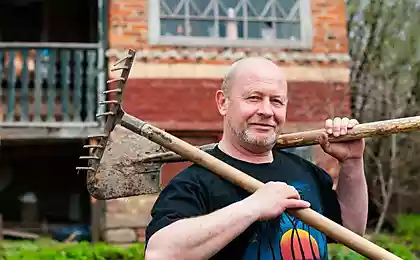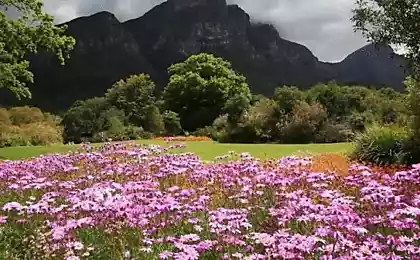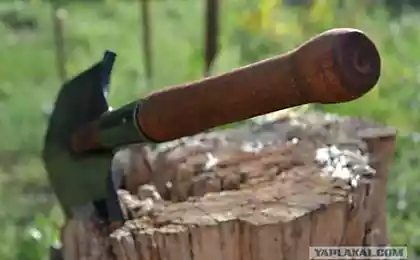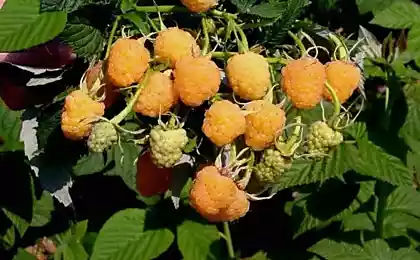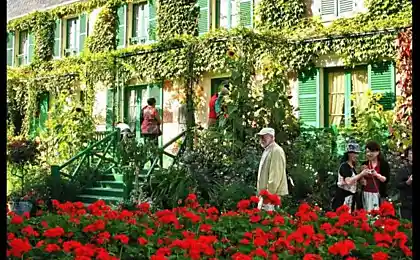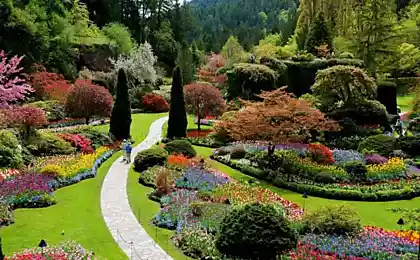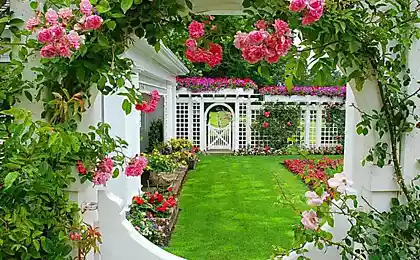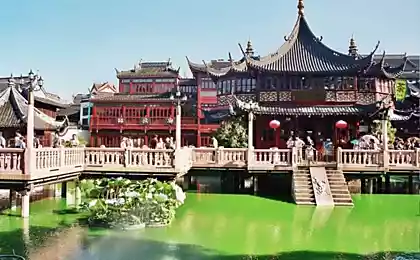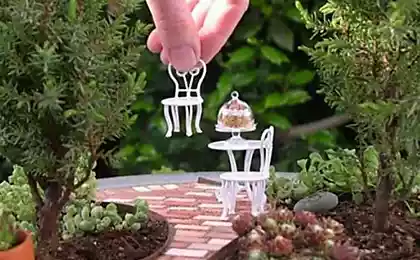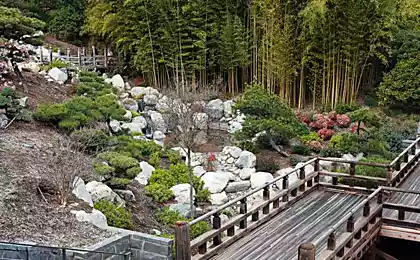580
How to create a productive garden on the sand without a shovel
Fifty five million eight hundred ninety four thousand four hundred sixty
5 years ago, when the youngest grandson was four years old, and the average went to the first class, the children helped me care for plants in the garden. «Smite! cried menshenky, turning to the elder. Is a bad stink!"But the first-grader wasn't in a hurry. He carefully examined the bug, the bug crawling on the trunk of a sapling Apple tree, then lifted the leaf, and from beneath it came a small family of turtles and hurried over to mom.
The eldest took the younger's hand and calmly began to teach him: "Nothing in nature can not touch, all beings benefit. Destroy one insect — will die a chain, it can. Let them live and understand each other."
My heart tightened with emotion. So, no wonder I grew a garden, which now you learn to observe the life of nature my grandchildren. Not I sit at the computer playing casino games–shooting, and watching the real struggle of small insects in the wild, learning her simple and wise laws.
So bloomed in my garden columnar Apple trees in 2014…
Fifty four million sixty five thousand seven hundred sixty nine
... and so they Mature in August.
Seventy eight million four hundred sixty two thousand sixty four
How did it all nacionalsocialismo 13 years ago. I already had 25 years of experience in the creation of 6 acres of garden on traditional technology, which is gradually lost from morozovoy. We were preparing for the wedding of his daughter and future son-in-law decided to lay a large new garden in a vacant lot.
For these purposes, I received in rent for 49 years 40 acres of derelict land. I liked that this southern slope near the lake, near my home.
But the land there was dead, clean sand, more than 6 meters to soil water. For many years here planted the potatoes at the potato, making only mineral water. Of humus in the soil does not remain. I decided that the land can recover.
Looking ahead: so looked the first flowering columnar Apple trees after 5 years of planting on the former vacant lot…
Ninety nine million two hundred forty nine thousand two hundred sixty two
... and so the first crop in the fifth year of life of the new garden.
Forty seven million nine hundred thirty two thousand nine hundred twenty six
Plow the plot, I did not, brought a few Truckloads of peat and the same sawdust. Were mulching gradually. Around young trees, the ground covered with peat, each planted sapling poured a bucket of rotted manure and a bucket of leaves from old, abandoned parks. Sawdust slipped on the tracks between the trees.
Grass not mowed, knocked down just what shade the younger trees. I knew that mowed green grass is a quick-acting nitrogenous fertilizer, with nitrogen the grass is quickly washed away by rain if its not to plow. But a plow and a spade I in the new garden decided not to apply.
Stable nitrogen gave the manure. In addition, I used a spoonful of urea locally into the hole at the root. And completely dried up the grass, which I left to grow until the autumn, is lignin, the food for fungi and subsequent chains of biota. It is the lignin in dry grass leads to the accumulation of humus in the soil in the long term. Doing so for the past 14 years.
Grade Butwas bloomed in 4 years.
Forty two million six hundred fifty one thousand seven hundred thirty four
Now — 13 year — is still low tree.
Fifty two million eighty nine thousand seventy six
But the crops from it are buckets.
Twelve million four hundred seventy three thousand nine hundred seventy five
In the last 10 years of his cheap organic matter (polupereprevshie manure in bags) make many — to 10 kg per square meter annually without digging, the piles on the perimeter of the crown. Soil engineers (not only earthworms, but smaller arthropods) it spread to a depth, and the litter the roots of the weeds does the job.
How it looks segodnyaschy, after 13 years of development, dead sand, under trees rich in organic matter loose layer is 30-40 cm, and bare sand without humus begins from a depth of 70 cm, deeper soil engineers organic to post yet. But 70 cm is now enough to retain moisture for tree growth.
Thirty two million three hundred sixty two thousand three hundred ninety six
Maximum yields giving the tree the Autumn Scarlet, planted seedlings.
Seventeen million seven hundred one thousand thirty three
The last four years I constantly sprayed my garden academic hours (Aerated Compost Tea) and HUMATE. It accelerates soil formation, the accumulation of stable humus and increases the biodiversity of soil animals. The batteries does not accumulate in the humus, not in the compost from which all of this is easily washed away in the sand and living bodies of soil biota.
Grass grow to five feet, there are many broad-leaved weeds, mountaineers, comfrey, Hogweed — they give way to flowering; they contain a lot of sugars that constantly feeds the soil biota.
Forty seven million two hundred eighty four thousand eight hundred eight
Autumn Scarlet — amazing taste September Apple.
Urea under the trees I made in the first five years, when the humus in the soil was not enough. Now mineral supplements don't do organics provides enough nutrients for the growth of trees in the garden. But in may, during a period of rapid growth herbs I sometimes weeds between rows where there is more sawdust and a little manure, fertilize with urea — it increases the accumulation of organic matter in the pregnany of the big mass of weeds.
A few words about green manure read More describe his observation as an argument for those who believe in the green manures and surface tillage as the basis of accumulation of organic matter in the soil.
Ninety eight million five hundred ninety nine thousand two hundred fifty five
On my site there are lots of pieces of land outside the trees, where peat, manure, leaves (i.e., organic matter) from the outside made very little. Grass (in fact, the cover crops) grow there permanently; shovel the soil is not known; academic hours, HUMATE and urea were made here, but for 14 years on these pieces of land has been empty the sand, and remained — an increase of humus is minimal. In the non-black earth green manure do not give a rapid increase of humus.
Ninety seven million three hundred forty eight thousand four hundred thirty one
Bloom 13-year-old columnar Apple trees generated "candelabra", amazingly beautiful.
The rapid accumulation of humus in the soil gives only the organic matter introduced from the outside, in combination with litter herbs-natives. One without the other works poorly.
The bucket of manure, dug sand, burns for a couple of years without a trace, if there is not grass roots. But by themselves, green manure for its growth are destroying soil organic matter as much how much we give. Nechernozemie because so called, that certain herbs accumulate the humus can not — the earth becomes black. Need organic from the outside, either.
And how to deal with watering?The rains we have enough. Drought happens in the summer every five years, and watering before I did. But now the trees have grown, Zapadnoye, and during the ripening of the fruit I bring petrol pump and trees with fruits a couple of times over the summer, well watered. The crop should be saved, if no rain for over three weeks.
The clay I brought in and scattered in a small area only once. Technically, time-consuming, of course, but there are trees in a drought feel more comfortable. I the clay soil is not mixed as recommended, is scattered under the canopy at the soil surface. Worms it mixed with leaf litter and carried deep into the.
Forty seven million nine hundred forty thousand five hundred ninety eight
Important role in the ecology of the garden playing grown up on the perimeter of the maple, Linden, ash, hawthorn and pine. Apple genetically like to grow on edges of forests, under the protection of tall trees.
And this bloom young Apple trees planted monastic way
Fifty five million forty one thousand five hundred one
What is the "monastic method" posadasii in detail, as I planted seedlings 10-13 years ago in the dead soil, when humus was not in it.
No pits did not. In the first year (partly fall, partly in the spring) went through the garden and at a distance of 2 x 2 meters were made small holes in which were planted five seeds of apples, pears, pitted plums, cherries (seeds, of course, arbeiterbund).
Isolated seedlings by autumn gave trunks the size of a pencil, perepravit they managed already to next spring, but the bulk of the grass survived and grew to half a meter only to fall 2-3 years.
This method is called the monastery. I found out about it when I visited Valaam and saw trees Apple trees that are several hundred years old. Secrets bookmark this garden is where I learned a lot.
Seventy eight million seven hundred thirty seven thousand nine hundred fifty eight
I, too, like the monks of Valaam, took the land on the southern slope, at the bottom of the lake. In the winter of stagnation of cold air there, and in the pre-winter evaporation of water extends the growing season of trees.
And on Valaam, and I used the seeds of the most hardy local polukulturnym Apple trees. The seedlings were given the root-stem, as inherent nature. Therefore, the highly nutritious layer of soil on top, which formed fibrous roots, does not violate alrnost and durability of my trees. And the pure the fruit they offer in the fall
Fifty one million four hundred ninety seven thousand six hundred eighty three
Scientists gardeners argue that the core of the root system is able to stock more products of photosynthesis (carbohydrates) in comparison with fibrous system (seedlings in commercial orchards). Carbohydrates (starch) and synthetic fats are accumulated and stored in the so-called parenchymal cells, located in the living layers of wood, in the medullary rays running through the wood and in the bark.
This improves the supply tree with a tap root system with food and water throughout the growing period. Storage in such a root system of a large stock of products of photosynthesis provides a good preparation of wood to winter and winter. In addition, the roots of the tree, located in the lower unfrozen layers of soil continue to grow all winter, which increases the overall dimensions and the suction ability of the root system prior to spring growth.
And on Valaam, and in my garden sprouted seedlings compete with weeds and survive the strongest. And the monks, in my garden many hundreds of varieties, pollination and good, but for pest freedom: the trees with different flowering times, different volatile and immunity.
Ninety six million three hundred sixty three thousand five hundred fifteen
Grass I mow, they bloom, which gives freedom for beneficial insects. The earth is not dug, the sheet is not removed, the environment is thus not disturbed. Mineral fertilizers are not applied, natural and introduced organic matter in abundance, while it is high in carbon content and this leads to a predominance of beneficial fungi saprophytes and reduce the putrefactive processes, which improves the ecology of the garden.
All these years I did to control and winter grafting of Apple and pear. Several hundred grafted and grown in the greenhouse seedlings were planted in the garden for comparison. In the upper part of the garden, where land and humus less vaccinated wildings of seeds ahead of winter grafting. But in the lowlands, where humus is more, it is the winter vaccinations in 10 years, given the most productive trees. True, and I cared for them better than the rest of the garden. At the same time, morozovoy on these artificial trees also had more.
Twenty one million four hundred fifty three thousand four hundred nineteen
Perfect autumn variety-new epic
After planting the seedling (winter shots) in poor sandy land I'm in fossa humus not poured. Made the mound out of a bucket of garden soil, after planting were mulching the perimeter of the crown humus, and watered every week with a weak infusion of organic matter.
In the following years locally to the root in autumn and spring was placed urea. Abundantly mulching of rotted manure, and autumn leaves from the Park. Recent years sprayed academic hours and HUMATE.
Here is a Mature sweet Ranetki
Seventy six million one hundred twenty thousand five hundred ninety six
And this is Altai, the novelty of Shushenskoye
Forty million seven hundred ninety five thousand one hundred twenty six
Conclusions and imagemodeler the results. I was digging holes for planting, not plowed land. And observe four rules:
Ninety five million six hundred thirty one thousand three hundred fifteen
So bloom five pears
Nineteen million seven hundred sixty five thousand four hundred thirty one
All this I have repeatedly discussed on the forums with growers in the last 7 years. Nobody believed that the sand can create a living, humus-rich soil to grow a garden of Apple trees and pears on a cold North-West. But here they are — pear Lipinska…
Twenty nine million five hundred forty thousand seven hundred twenty nine
... and early sweet pear in early August.
Ten million nine hundred seventy nine thousand six hundred seventy five
I did it at all it shows. Now in the collection of more than a dozen columnar Apple trees, and all survived, yield abundant crops annually. Began to bear fruit capricious European and American varieties. Looked very good late in the Belarusian Apple breeding, but in our area the winter varieties for long-term storage no.
Ninety million two hundred twenty four thousand two hundred forty three
Let me remind you of the garden I created almost alone, without help — the wife is busy with flowers and vegetables, children are constantly at work, grandchildren help harvest and relax in the garden, call it our garden-oasis. I described the technology without digging planting holes and digging soil — low cost and affordable to anyone in love in the garden person.published
P. S. And remember, only by changing their consumption — together we change the world! ©
Source: www.7dach.ru
5 years ago, when the youngest grandson was four years old, and the average went to the first class, the children helped me care for plants in the garden. «Smite! cried menshenky, turning to the elder. Is a bad stink!"But the first-grader wasn't in a hurry. He carefully examined the bug, the bug crawling on the trunk of a sapling Apple tree, then lifted the leaf, and from beneath it came a small family of turtles and hurried over to mom.
The eldest took the younger's hand and calmly began to teach him: "Nothing in nature can not touch, all beings benefit. Destroy one insect — will die a chain, it can. Let them live and understand each other."
My heart tightened with emotion. So, no wonder I grew a garden, which now you learn to observe the life of nature my grandchildren. Not I sit at the computer playing casino games–shooting, and watching the real struggle of small insects in the wild, learning her simple and wise laws.
So bloomed in my garden columnar Apple trees in 2014…
Fifty four million sixty five thousand seven hundred sixty nine
... and so they Mature in August.
Seventy eight million four hundred sixty two thousand sixty four
How did it all nacionalsocialismo 13 years ago. I already had 25 years of experience in the creation of 6 acres of garden on traditional technology, which is gradually lost from morozovoy. We were preparing for the wedding of his daughter and future son-in-law decided to lay a large new garden in a vacant lot.
For these purposes, I received in rent for 49 years 40 acres of derelict land. I liked that this southern slope near the lake, near my home.
But the land there was dead, clean sand, more than 6 meters to soil water. For many years here planted the potatoes at the potato, making only mineral water. Of humus in the soil does not remain. I decided that the land can recover.
Looking ahead: so looked the first flowering columnar Apple trees after 5 years of planting on the former vacant lot…
Ninety nine million two hundred forty nine thousand two hundred sixty two
... and so the first crop in the fifth year of life of the new garden.
Forty seven million nine hundred thirty two thousand nine hundred twenty six
Plow the plot, I did not, brought a few Truckloads of peat and the same sawdust. Were mulching gradually. Around young trees, the ground covered with peat, each planted sapling poured a bucket of rotted manure and a bucket of leaves from old, abandoned parks. Sawdust slipped on the tracks between the trees.
Grass not mowed, knocked down just what shade the younger trees. I knew that mowed green grass is a quick-acting nitrogenous fertilizer, with nitrogen the grass is quickly washed away by rain if its not to plow. But a plow and a spade I in the new garden decided not to apply.
Stable nitrogen gave the manure. In addition, I used a spoonful of urea locally into the hole at the root. And completely dried up the grass, which I left to grow until the autumn, is lignin, the food for fungi and subsequent chains of biota. It is the lignin in dry grass leads to the accumulation of humus in the soil in the long term. Doing so for the past 14 years.
Grade Butwas bloomed in 4 years.
Forty two million six hundred fifty one thousand seven hundred thirty four
Now — 13 year — is still low tree.
Fifty two million eighty nine thousand seventy six
But the crops from it are buckets.
Twelve million four hundred seventy three thousand nine hundred seventy five
In the last 10 years of his cheap organic matter (polupereprevshie manure in bags) make many — to 10 kg per square meter annually without digging, the piles on the perimeter of the crown. Soil engineers (not only earthworms, but smaller arthropods) it spread to a depth, and the litter the roots of the weeds does the job.
How it looks segodnyaschy, after 13 years of development, dead sand, under trees rich in organic matter loose layer is 30-40 cm, and bare sand without humus begins from a depth of 70 cm, deeper soil engineers organic to post yet. But 70 cm is now enough to retain moisture for tree growth.
Thirty two million three hundred sixty two thousand three hundred ninety six
Maximum yields giving the tree the Autumn Scarlet, planted seedlings.
Seventeen million seven hundred one thousand thirty three
The last four years I constantly sprayed my garden academic hours (Aerated Compost Tea) and HUMATE. It accelerates soil formation, the accumulation of stable humus and increases the biodiversity of soil animals. The batteries does not accumulate in the humus, not in the compost from which all of this is easily washed away in the sand and living bodies of soil biota.
Grass grow to five feet, there are many broad-leaved weeds, mountaineers, comfrey, Hogweed — they give way to flowering; they contain a lot of sugars that constantly feeds the soil biota.
Forty seven million two hundred eighty four thousand eight hundred eight
Autumn Scarlet — amazing taste September Apple.
Urea under the trees I made in the first five years, when the humus in the soil was not enough. Now mineral supplements don't do organics provides enough nutrients for the growth of trees in the garden. But in may, during a period of rapid growth herbs I sometimes weeds between rows where there is more sawdust and a little manure, fertilize with urea — it increases the accumulation of organic matter in the pregnany of the big mass of weeds.
A few words about green manure read More describe his observation as an argument for those who believe in the green manures and surface tillage as the basis of accumulation of organic matter in the soil.
Ninety eight million five hundred ninety nine thousand two hundred fifty five
On my site there are lots of pieces of land outside the trees, where peat, manure, leaves (i.e., organic matter) from the outside made very little. Grass (in fact, the cover crops) grow there permanently; shovel the soil is not known; academic hours, HUMATE and urea were made here, but for 14 years on these pieces of land has been empty the sand, and remained — an increase of humus is minimal. In the non-black earth green manure do not give a rapid increase of humus.
Ninety seven million three hundred forty eight thousand four hundred thirty one
Bloom 13-year-old columnar Apple trees generated "candelabra", amazingly beautiful.
The rapid accumulation of humus in the soil gives only the organic matter introduced from the outside, in combination with litter herbs-natives. One without the other works poorly.
The bucket of manure, dug sand, burns for a couple of years without a trace, if there is not grass roots. But by themselves, green manure for its growth are destroying soil organic matter as much how much we give. Nechernozemie because so called, that certain herbs accumulate the humus can not — the earth becomes black. Need organic from the outside, either.
And how to deal with watering?The rains we have enough. Drought happens in the summer every five years, and watering before I did. But now the trees have grown, Zapadnoye, and during the ripening of the fruit I bring petrol pump and trees with fruits a couple of times over the summer, well watered. The crop should be saved, if no rain for over three weeks.
The clay I brought in and scattered in a small area only once. Technically, time-consuming, of course, but there are trees in a drought feel more comfortable. I the clay soil is not mixed as recommended, is scattered under the canopy at the soil surface. Worms it mixed with leaf litter and carried deep into the.
Forty seven million nine hundred forty thousand five hundred ninety eight
Important role in the ecology of the garden playing grown up on the perimeter of the maple, Linden, ash, hawthorn and pine. Apple genetically like to grow on edges of forests, under the protection of tall trees.
And this bloom young Apple trees planted monastic way
Fifty five million forty one thousand five hundred one
What is the "monastic method" posadasii in detail, as I planted seedlings 10-13 years ago in the dead soil, when humus was not in it.
No pits did not. In the first year (partly fall, partly in the spring) went through the garden and at a distance of 2 x 2 meters were made small holes in which were planted five seeds of apples, pears, pitted plums, cherries (seeds, of course, arbeiterbund).
Isolated seedlings by autumn gave trunks the size of a pencil, perepravit they managed already to next spring, but the bulk of the grass survived and grew to half a meter only to fall 2-3 years.
This method is called the monastery. I found out about it when I visited Valaam and saw trees Apple trees that are several hundred years old. Secrets bookmark this garden is where I learned a lot.
Seventy eight million seven hundred thirty seven thousand nine hundred fifty eight
I, too, like the monks of Valaam, took the land on the southern slope, at the bottom of the lake. In the winter of stagnation of cold air there, and in the pre-winter evaporation of water extends the growing season of trees.
And on Valaam, and I used the seeds of the most hardy local polukulturnym Apple trees. The seedlings were given the root-stem, as inherent nature. Therefore, the highly nutritious layer of soil on top, which formed fibrous roots, does not violate alrnost and durability of my trees. And the pure the fruit they offer in the fall
Fifty one million four hundred ninety seven thousand six hundred eighty three
Scientists gardeners argue that the core of the root system is able to stock more products of photosynthesis (carbohydrates) in comparison with fibrous system (seedlings in commercial orchards). Carbohydrates (starch) and synthetic fats are accumulated and stored in the so-called parenchymal cells, located in the living layers of wood, in the medullary rays running through the wood and in the bark.
This improves the supply tree with a tap root system with food and water throughout the growing period. Storage in such a root system of a large stock of products of photosynthesis provides a good preparation of wood to winter and winter. In addition, the roots of the tree, located in the lower unfrozen layers of soil continue to grow all winter, which increases the overall dimensions and the suction ability of the root system prior to spring growth.
And on Valaam, and in my garden sprouted seedlings compete with weeds and survive the strongest. And the monks, in my garden many hundreds of varieties, pollination and good, but for pest freedom: the trees with different flowering times, different volatile and immunity.
Ninety six million three hundred sixty three thousand five hundred fifteen
Grass I mow, they bloom, which gives freedom for beneficial insects. The earth is not dug, the sheet is not removed, the environment is thus not disturbed. Mineral fertilizers are not applied, natural and introduced organic matter in abundance, while it is high in carbon content and this leads to a predominance of beneficial fungi saprophytes and reduce the putrefactive processes, which improves the ecology of the garden.
All these years I did to control and winter grafting of Apple and pear. Several hundred grafted and grown in the greenhouse seedlings were planted in the garden for comparison. In the upper part of the garden, where land and humus less vaccinated wildings of seeds ahead of winter grafting. But in the lowlands, where humus is more, it is the winter vaccinations in 10 years, given the most productive trees. True, and I cared for them better than the rest of the garden. At the same time, morozovoy on these artificial trees also had more.
Twenty one million four hundred fifty three thousand four hundred nineteen
Perfect autumn variety-new epic
After planting the seedling (winter shots) in poor sandy land I'm in fossa humus not poured. Made the mound out of a bucket of garden soil, after planting were mulching the perimeter of the crown humus, and watered every week with a weak infusion of organic matter.
In the following years locally to the root in autumn and spring was placed urea. Abundantly mulching of rotted manure, and autumn leaves from the Park. Recent years sprayed academic hours and HUMATE.
Here is a Mature sweet Ranetki
Seventy six million one hundred twenty thousand five hundred ninety six
And this is Altai, the novelty of Shushenskoye
Forty million seven hundred ninety five thousand one hundred twenty six
Conclusions and imagemodeler the results. I was digging holes for planting, not plowed land. And observe four rules:
- Have made many different organics.
- Kept the roots of wild weeds.
- Making fertilizer locally.
- Made microorganisms and humates.
Ninety five million six hundred thirty one thousand three hundred fifteen
So bloom five pears
Nineteen million seven hundred sixty five thousand four hundred thirty one
All this I have repeatedly discussed on the forums with growers in the last 7 years. Nobody believed that the sand can create a living, humus-rich soil to grow a garden of Apple trees and pears on a cold North-West. But here they are — pear Lipinska…
Twenty nine million five hundred forty thousand seven hundred twenty nine
... and early sweet pear in early August.
Ten million nine hundred seventy nine thousand six hundred seventy five
I did it at all it shows. Now in the collection of more than a dozen columnar Apple trees, and all survived, yield abundant crops annually. Began to bear fruit capricious European and American varieties. Looked very good late in the Belarusian Apple breeding, but in our area the winter varieties for long-term storage no.
Ninety million two hundred twenty four thousand two hundred forty three
Let me remind you of the garden I created almost alone, without help — the wife is busy with flowers and vegetables, children are constantly at work, grandchildren help harvest and relax in the garden, call it our garden-oasis. I described the technology without digging planting holes and digging soil — low cost and affordable to anyone in love in the garden person.published
P. S. And remember, only by changing their consumption — together we change the world! ©
Source: www.7dach.ru
12 low-calorie Breakfast that are worth a try
Rare human diseases that are associated with the psyche
